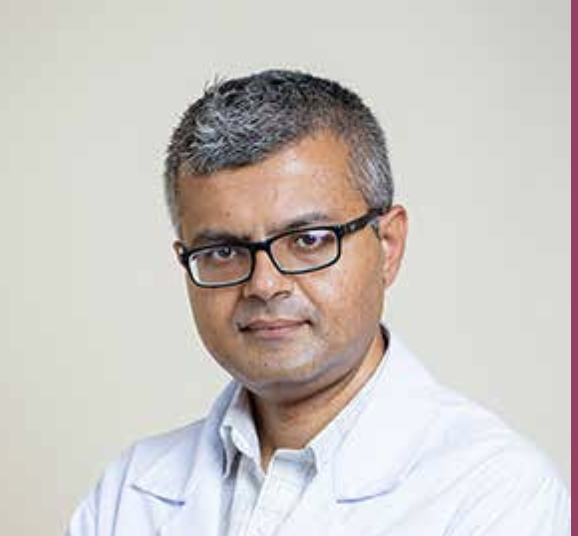
Dr. Amrit Ghimire is a Consultant Pediatric Pulmonologist at the Department of Pediatrics & Neonatology, Grande International Hospital. He also serves as the Chairperson of the Pediatric Pulmonology Chapter of the Nepal Pediatric Society.
With extensive expertise in managing childhood respiratory disorders, Dr. Ghimire’s key areas of interest include pediatric asthma and allergies. He completed his M.B.B.S. and M.D. in Pediatrics, followed by a specialized fellowship in Pediatric Pulmonology.
Dr. Ghimire has further enhanced his training through the AIIMS Pediatric Pulmonology and Intensive Course, a CME on Disease-Specific Neonatal Ventilation, a Workshop on Inhalation Therapy, an Advanced Course in Pediatric Intensive Care, a Pediatric Bronchoscopy Workshop, and a Training Course in Pediatric Advanced Life Support.
He remains deeply committed to advancing pediatric pulmonology and improving the respiratory health and overall well-being of children.
Sleep and Its Patterns in Childhood
Sleep is a dynamic physiological process that changes in duration, pattern, and function as a child grows. Newborns spend most of their time asleep. As the child matures, total sleep time decreases, nighttime sleep consolidates, and daytime naps gradually disappear.
Sleep patterns are strongly influenced by neurodevelopment, circadian rhythms, and environmental factors, making them highly variable across ages. Disruption in sleep can affect growth, cognition, behavior, and emotional regulation. Understanding this dynamism helps in promoting healthy sleep practices and overall child well-being.
About one in four healthy-looking children may have a sleep-related complaint at any given time. Most are transient and self-limiting, but parental distress often prompts specialist consultation. There is paucity of data in Nepal on the prevalence of sleep patterns and problems in children.
The information is drawn mainly from western studies where children are solitary sleepers (sleeping in their own bed), unlike children in many South Asian countries including Nepal, where co-sleeping (sleeping in the parental bed) is culturally a rite of passage.
Normal Sleep Patterns in Childhood
Normal sleep patterns in childhood vary with age:
- Newborns (0–3 months): Sleep 14–17 hours daily in short cycles, with roughly equal REM and non-REM sleep.
- Infants (4–12 months): Sleep consolidates to 12–16 hours, and REM decreases.
- Toddlers (1–3 years): Need 11–14 hours.
- Preschoolers (3–5 years): Need 10–13 hours.
- School-aged children (6–12 years): Need 9–12 hours, usually without naps.
- Adolescents: Require 8–10 hours.
Brief awakenings and dreaming are normal. There are two periods of maximum sleepiness — 3:00–5:00 p.m. in the afternoon and 3:00–5:00 a.m. towards the end of the night — and two periods of maximum alertness, observed in mid-morning and immediately before sleep onset in the evening. Recognizing these patterns helps parents maintain good sleep hygiene and identify problems early.
REM and NREM Sleep
Sleep is divided into two physiologically distinct categories: Rapid Eye Movement (REM) and Non-Rapid Eye Movement (NREM).
NREM sleep is divided into stages of light and deep sleep. It is restorative, promoting physical growth through growth hormone secretion, immune function, and cellular repair. Deep NREM sleep consolidates factual memory.
REM sleep, in contrast, is characterized by dreaming, rapid eye movements, and high brain activity. It may not be a fully restorative form of sleep, but it is involved in vital cognitive functions as well as growth and development of the central nervous system. It is crucial for emotional regulation, learning, and memory consolidation—particularly language and problem-solving skills.
Newborns spend about half of their sleep in REM; by age five, it falls to about 20% and remains stable through life. Proper balance of REM and NREM sleep ensures healthy physical growth, cognitive development, emotional stability, and overall well-being in children.
Evaluation of Sleep Problems in Children
Children commonly present to primary care physicians or pediatricians with three main types of sleep-related problems. About one in four healthy-looking children may have a sleep-related complaint at any given time.
Sleep problems in children are broadly classified into three categories:
- Dyssomnias – Disorders of initiating and maintaining sleep.
- Hypersomnias – Conditions characterized by excessive daytime sleepiness.
- Parasomnias – Abnormal activities or behaviors occurring during sleep.
Types of Sleep Problems
1. Dyssomnias
Difficulty initiating or maintaining sleep.
- Infants: May rely on rocking or feeding to fall asleep.
- Toddlers: Often show bedtime resistance.
- Older children: May have poor sleep hygiene or irregular routines.
Frequent night waking is also common.
Management:
- Establish consistent bedtime routines.
- Encourage self-soothing.
- Avoid feeding or rocking as the only sleep cue.
In toddlers and preschoolers, behavioral insomnia of childhood is common, often due to limit-setting problems where children resist going to bed.
Approach:
- Gentle but firm parental limit setting.
- Structured bedtime rituals.
- Positive reinforcement for independent sleeping.
In school-aged children, dyssomnias may stem from inadequate sleep hygiene, such as late bedtimes or excessive screen time, leading to irritability and poor academic performance.
Management includes:
- Strict sleep schedules.
- Limiting screen time before bed.
- Morning exposure to bright light to reset the circadian rhythm.
Overall, management of dyssomnias emphasizes behavioral interventions, parental guidance, structured routines, and lifestyle modification.
Medications are rarely required and should only be considered for older children or adolescents with persistent sleep difficulties under specialist supervision.
2. Hypersomnias
Excessive daytime sleepiness.
- Infants: May result from neurological conditions, congenital brain malformations, or metabolic disorders.
- Management: Evaluate for underlying medical causes.
- Toddlers and Preschoolers: Common causes include insufficient sleep due to behavioral insomnia or obstructive sleep apnea (OSA).
- Management:
- Treat sleep-disordered breathing (e.g., adenotonsillectomy for OSA).
- Correct iron deficiency.
- Improve sleep hygiene.
- Management:
- School-aged children: Often linked to sleep apnea, poor sleep hygiene, or chronic illness.
- Management:
- Maintain regular sleep routines.
- Reduce screen exposure.
- Treat underlying medical conditions.
- Management:
3. Parasomnias
Abnormal activities during sleep, such as:
- Sleep terrors
- Nightmares and fears
- Sleepwalking
- Sleep talking
- Bruxism (teeth grinding)
Most parasomnias are benign, related to neurological immaturity, and improve with age.
Management:
- Provide reassurance to parents.
- Ensure safety measures at home (secure environment).
- Optimize sleep routines.
- Medications are rarely necessary.
Sleep Terror
Sleep terrors are one of the common sleep disorders characterized by a state of confusion and partial arousal, usually during the first third of the night. They are episodic in nature and reflect central nervous system immaturity.
Sleep terrors are most common in children between four and twelve years of age. Facial expressions of terror or intense fear are associated with uncontrollable shouting, screaming, gasping, moaning, or agitation. Most children outgrow their sleep terrors as they mature neurophysiologically.
Management:
Management of sleep terrors starts with parental reassurance and guidance. Sleep hygiene changes should be implemented, as sleep deprivation is the most common trigger. Avoid late bedtimes, as they may provoke sleep terrors. Efforts should be made to alleviate stress in the child’s environment.
Short-acting benzodiazepines may be considered for 3 to 6 months if there is danger of self-harm or violent activity.
Nightmares
These events usually occur in the last third phase of sleep. They are characterized by disturbing dreams associated with post-event anxiety and refusal to go back to sleep.
Nightmares are sometimes precipitated by stressful or traumatic experiences and are most commonly seen in children aged 6 to 10 years.
Management:
- Maintain good sleep hygiene.
- Avoid exposure to frightening bedtime television shows or media.
- Provide parental reassurance.
- Keeping a low-level night light in the room may help comfort the child.
Night-time Fears
Childhood fears are normal and often developmentally related. Many children experience fears that manifest in various ways—half of all children fear sleeping alone.
Common fears include darkness, lizards, ghosts, and thunderstorms.
A helpful approach to managing nighttime fears is through book reading and storytelling. Bedtime stories with discussions, drawings, or cartoons that portray darkness positively have been used successfully to treat such fears.
Somnambulism (Sleep Walking)
In sleepwalking, a child walks during sleep in an altered state of consciousness or impaired judgment. The child usually walks with open eyes and appears confused or dazed.
Sleepwalking is associated with safety concerns such as falling, injury, or wandering outside. Sleep deprivation or febrile illness may precipitate episodes.
Management:
- Focus on protecting the child from harm.
- Maintain good sleep hygiene.
- Avoid sleep deprivation.
Sleep Talking (Somniloquy)
Sleep talking consists of vocalizations—often nonsensical—during both REM and non-REM sleep. It may coexist with other parasomnias such as sleepwalking or sleep terrors.
Management:
Sleep talking is a benign condition and does not require treatment.
Sleep Bruxism
Sleep bruxism is characterized by forceful grinding or rhythmic clenching of the teeth or rhythmic movements of the jaw during sleep.
Though evidence is limited, emotional and psychological factors are believed to contribute to the pathophysiology of sleep bruxism.
Management:
- Most cases are managed with behavioral strategies such as maintaining sleep hygiene.
- Occasionally, benzodiazepines or muscle relaxants may be tried.
- Severe cases may lead to temporomandibular disorders, which require orthodontic treatment.
Delayed Sleep Phase Disorder
This is a circadian rhythm disorder characterized by an intractable and persistent phase shift, leading to delayed sleep onset and wake time. It usually presents as difficulty in initiating sleep at a socially acceptable hour.
 Medicosnext
Medicosnext




